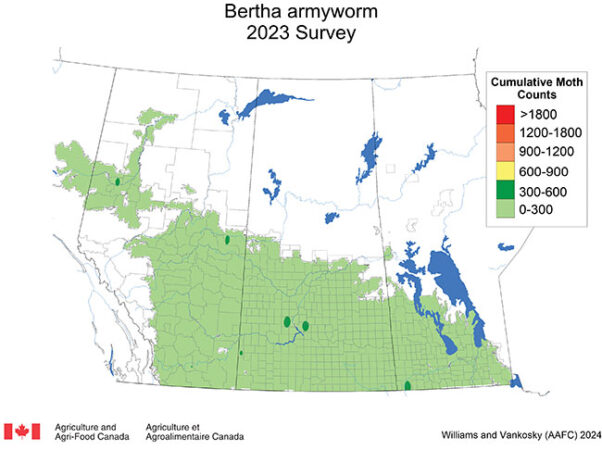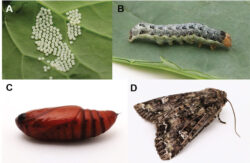
Features
Pests
Predicting insect pest risks on the Prairies
Insect pest monitoring and survey data enhance risk prediction modelling.
May 5, 2024 By Donna Fleury
 Grasshopper nymphs caught in a sweep net in July 2023.
Photo courtesy of Meghan Vankosky, AAFC-Saskatoon.
Grasshopper nymphs caught in a sweep net in July 2023.
Photo courtesy of Meghan Vankosky, AAFC-Saskatoon. Through the Prairie Pest Monitoring Network (PPMN), growers across the Prairies have access to extensive tools and resources for assessing insect pest risk and making informed management decisions. Established in 1997, PPMN provides growers with insect pest monitoring and management information, including weekly in-season updates and maps showing the distribution and relative abundance of priority insect pests. The network also employs models to predict when insect pests will be active, aiding farmers in timing their on-farm scouting during the growing season.
“A new five-year project launched in 2023 provides funding to continue the monitoring and annual surveys conducted by PPMN and includes funding for additional research specific to some of the current priority insect pest populations on the Prairies,” explains Meghan Vankosky, field crop entomologist with Agriculture and Agri-Food Canada (AAFC) in Saskatoon, Sask. “This includes lab and field experiments to help create more detailed profiles of pest behaviour, development and population dynamics. Detailed insect pest profiles are necessary to identify the cycles and patterns of insect pest populations and to create models that predict their behaviour and risks to prairie cropping systems.”
One of the research priorities is to better understand grasshopper biology. Only a handful of grasshopper species are considered economic threats, including the clear-winged grasshopper, Packard’s grasshopper, the migratory grasshopper and the two-striped grasshopper.
“However, in the Aspen Parkland region of the Prairies, including around Edmonton and in the Peace River regions in Alberta, the Bruner’s spur-throated grasshopper tends to be very prevalent every second year,” says Vankosky. “The Bruner’s grasshopper appears to have a two-year life cycle compared to a one-year cycle more common for other grasshopper species. Research at the AAFC Research Farm in Beaverlodge, led by Jennifer Otani, is being conducted to learn more about the factors driving Bruner’s grasshopper development, population changes and distribution.”
Another research project, led by Boyd Mori, assistant professor of agricultural and ecological entomology at the University of Alberta, is conducting lab experiments to assess the current status of insecticide resistance in populations of pea leaf weevil, cabbage seedpod weevil and diamondback moth in Western Canada. The project started assessing populations in Alberta in 2023 and will be expanding to include populations from across Saskatchewan and Manitoba over the five-year project.

Results of the 2023 bertha armyworm monitoring program; cumulative capture of male bertha armyworm moths was below 300 per trap at the majority of sampling sites across the Prairie region in 2023.
Map by Jonathon Williams, AAFC-Saskatoon, with data provided by Alberta Agriculture and Irrigation, Saskatchewan Ministry of Agriculture, Manitoba Agriculture and their partners.
Vankosky adds that although insecticide resistance is not generally considered a problem for most insect pests on the Prairies, it is important to assess and proactively manage. It is crucial to know whether there are populations of these insect pests that are becoming or could potentially become resistant to pesticides typically used to manage them.
“Looking forward to the 2024 cropping season, potential insect pest issues will depend on field location and weather conditions,” says Vankosky. “We encourage growers to review the insect pests that were a problem in their area last year. Then, go to the PPMN website and look at the 2023 pest risk maps to see the density for their area, which informs what to expect in 2024. All of the maps for the key insect pests should be available on the website by the end of March. For example, bertha armyworm populations were low in 2023, so there probably isn’t a lot of risk for 2024, but it’s still important to be vigilant.”
Vankosky emphasizes that weather is one of the significant factors impacting the risk of various insect pests. Insects that prefer hot and dry weather include grasshoppers, wheat stem sawfly, crucifer flea beetle and diamondback moth. Conversely, insects that thrive in cool and wet weather include wheat midge, striped flea beetle, cabbage seedpod weevil, and swede midge.

The egg, larval, pupal and adult stages of development of bertha armyworm.
Photo courtesy of Jonathon Williams, AAFC-Saskatoon.
“If hot and dry conditions continue like last year, then grasshoppers are going to be a significant potential issue for growers in 2024. If we have a dry, warm spring like last year, then grasshopper development can start very early. Start scouting early in May, looking for very tiny grasshopper nymphs and consider applying insecticides early if densities exceed economic thresholds. Grasshoppers are much easier to manage with insecticides when they are nymphs. If conditions stay hot and dry in 2024 in southern Alberta and southwest Saskatchewan, then wheat stem sawfly could also be problematic in those areas. However, if we get a cooler and wetter spring, then issues with wheat midge are more likely than issues with grasshoppers and wheat stem sawfly.”
The PPMN relies heavily on volunteers, including farmers, agronomists, researchers, industry commissions and provincial experts, to assist with monitoring and annual surveys. Researchers are always looking for partners willing to share data or to have researchers come onto their farms to collect samples, set up pheromone traps or provide other support for the survey and monitoring work.
In Alberta, Shelley Barkley, with Alberta Agriculture and Irrigation, leads the insect monitoring work. John Gavloski, with Manitoba Agriculture, leads the insect monitoring in Manitoba. In Saskatchewan, there is a Saskatchewan Agriculture database grower volunteers can sign up for if interested to allow access to their land and to get involved with monitoring. Growers can also contact Vankosky directly if they have questions or want to learn more about getting involved with insect monitoring activities.
“In collaboration with our partners and volunteers, we continue to grow and improve our knowledge and resources of priority insect pests and risk prediction capabilities,” notes Vankosky. “It will take a few years to collect and analyze all of the data from the various projects. In the meantime, we will continue with annual monitoring and other activities, which, combined with historic and current pest monitoring data, will contribute to expanding and improving pest risk models. Researchers will be able to use different models to assess potential pest populations under different climate and weather scenarios to provide current and future insect pest distribution and forecasts. Ultimately, this will help researchers and growers be better prepared to make informed management decisions to reduce the impacts of insect pests in field crops across the Prairies.”
The project is co-funded by the Saskatchewan Agriculture Development Fund (ADF) and several industry commissions and organizations. For more information, visit prairiepest.ca.